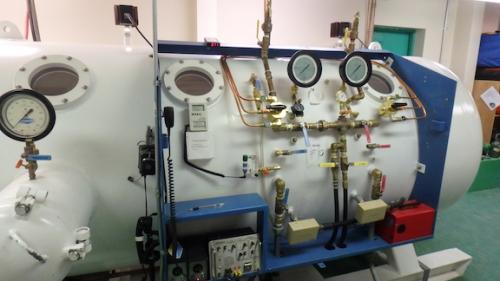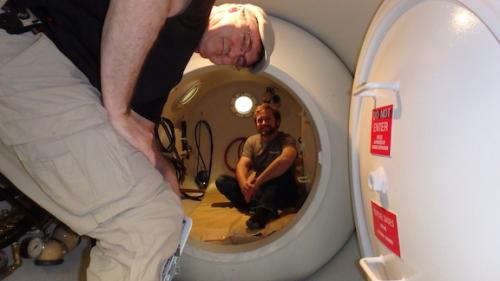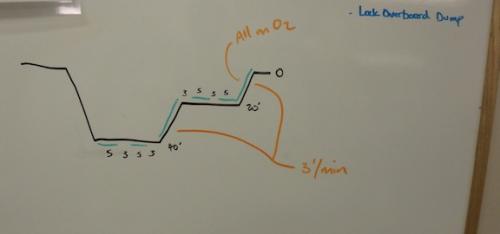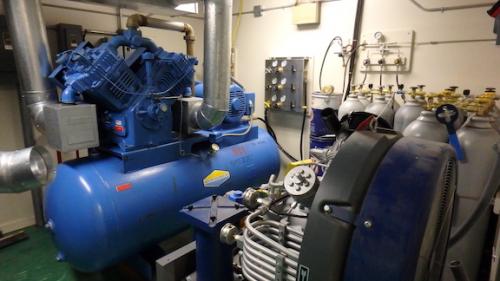 McMurdo Station's hyperbaric chamber.
McMurdo Station's hyperbaric chamber.
The USAP scientific diving program maintains and operates a hyperbaric, or "recompression," chamber at McMurdo Station, an important safety net for those using SCUBA to accomplish their science so far away from advanced medical facilities. Should one of us experience decompression sickness (DCS), a "dive" in a recompression chamber is the best possible treatment. Briefly, DCS or "the bends" is caused by nitrogen gas bubbling out of blood and tissues when a diver reduces pressure on their body by ascending too rapidly. The best way to treat the bubbles is to "recompress" them in a chamber, dissolving the bubbles back into the blood so the gas can be eliminated through normal breathing. During a systems test of the McMurdo chamber today, I get to experience my first chamber "dive."
 Infirmary physician Dr. Mike Smith acts as the patient tender and I serve as the "patient" in this simulated treatment.
Infirmary physician Dr. Mike Smith acts as the patient tender and I serve as the "patient" in this simulated treatment.
In 1984, the USAP scientific diving program expanded its margin of safety by installing their chamber system. Since its installation, the chamber has treated four aviators (they experience DCS as well) and seven divers - a very small fraction of the 16,000 individual USAP dives occurring over the same period. During the spring diving season, the chamber team - made up of the diving supervisors, station medical staff, firefighters, and Mechanical Equipment Center volunteers - regularly prepare for diving and flight emergencies by performing practice runs. The chamber itself is a large steel cylinder, approximately 4ft/1.5m in diameter and 15ft/5m long. There is a large entry hatch at one end and an internal hatch, separating the interior space into two smaller compartments. The outer compartment is an airlock, allowing medical staff and equipment to be transferred in an out over the course of a four and a half hour standard hyperbaric treatment. The inner chamber has enough floor space for a bed, as well as several viewing ports, intercoms, and a regulator & mask setup for breathing pure oxygen at regular intervals (an important part of the hyperbaric treatment). The whole system is supported by an air compressor in a separate room with banks of air and oxygen gases, enough for a complete chamber series.
 The chamber operators' schematic of our planned treatment "depths" and times.
The chamber operators' schematic of our planned treatment "depths" and times.
Dr. Mike Smith acts as the tender on our dive and I am the simulated patient. Rather than experiencing the full treatment, we're only going "down" to 40ft/12m. Before climbing in, I remove shoes, electronics, and my synthetic fleece jacket (static electricity discharge inside causes problems). Dr. Smith and I wear ear protection as we start to descend, giving hand signals through the view ports to Tony Buchanan, the chamber operator working the various valves and controls outside. The movement of pressurized air is surprisingly loud inside the chamber - my first impression. My second impression is that it gets very warm, very quickly (gases warm up as they are pressurized). I'm immediately glad that we're not going any "deeper." After cooler air is cycled through the chamber, Dr. Smith and I remove our headsets. As I start to talk, I'm startled to hear the sound of my own voice, which is a few notches higher than I'm used to hearing. "Micky Mouse voice," Dr. Smith explains, is caused by denser air moving across our vocal cords. To me, it sounds hilarious and speaking over the intercom with Buchanan on the outside to confirm oxygen mask treatment timing, I'm having difficulty taking myself seriously. After about twenty minutes, Buchanan slowly releases the pressure, bringing us "up" to 20ft/6m where we go through another series of mask-on, mask-off treatments. After another twenty minutes, we "ascend" to the surface and open the hatch, a little cooler but otherwise no worse for the wear. In the end, I get to log a 46 minute "dive," having never actually gone anywhere except the chamber facility attached to McMurdo's clinic. However, the practice and training leaves me an immeasurably more experienced diver.
 The air compressor squeezes air into the storage tanks, which hold enough air for a full chamber treatment and will even operate in the event of a power failure.
The air compressor squeezes air into the storage tanks, which hold enough air for a full chamber treatment and will even operate in the event of a power failure.

Comments